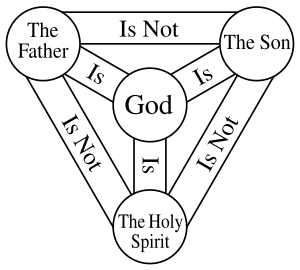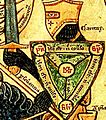Athanasian Creed facts for kids
The Athanasian Creed is an important Christian statement of faith. A creed is like a summary of what people believe. It is also known as Quicumque vult, which means "Whoever wants" in Latin. This creed was the first to clearly explain the idea of the Trinity.
The Trinity is the Christian belief that God is one, but exists as three "persons": God the Father, God the Son (Jesus Christ), and God the Holy Spirit. This creed has been used since the 6th century, mostly in the Western Church. Today, it is not used as much. The Nicene Creed is more common.
For a long time, people thought Saint Athanasius wrote this creed. He lived in Egypt in the 4th century. However, most experts today believe he did not write it.
Here's why:
- The original text is in Latin. Athanasius mainly wrote in Greek.
- Neither Athanasius nor others from his time mentioned this creed.
- The creed talks about religious problems that came up after Athanasius died.
Most experts now think the Athanasian Creed was written around the year 500 in Gaul (which is now France). Its ideas are similar to those of important Christian thinkers like Saint Ambrose of Milan and Augustine of Hippo. Some scholars think Caesarius of Arles might have written it.
The oldest copies of the Athanasian Creed that we still have are from the late 8th century.
Martin Luther, a key figure in Christian history, said there were three main statements of faith. These were the Nicene Creed, the Te Deum, and the Athanasian Creed.
The Athanasian Creed begins by saying:
Quicumque vult salvus esse, ante omnia opus est, ut teneat catholicam fidem: quam nisi quisque integram inviolatamque servaverit, absque dubio in aeternum peribit.
Whoever wants to be saved should above all cling to the catholic faith. Whoever does not guard it whole and inviolable will doubtless perish eternally.
It explains the Trinity in a way that goes against other beliefs, like Arianism. Arianism was a belief that Jesus was not fully God. The creed also includes the filioque part. This means the Holy Spirit comes from the Father and the Son.
The creed ends with these words:
Haec est fides catholica; quam nisi quisque fideliter firmiterque crediderit, salvus esse non poterit.
This is the catholic faith. One cannot be saved without believing this firmly and faithfully.
Images for kids
-
Athanasius of Alexandria was traditionally thought to be the author of the Athanasian Creed, and gives his name to its common title.
See also
 In Spanish: Símbolo Quicumque para niños
In Spanish: Símbolo Quicumque para niños




